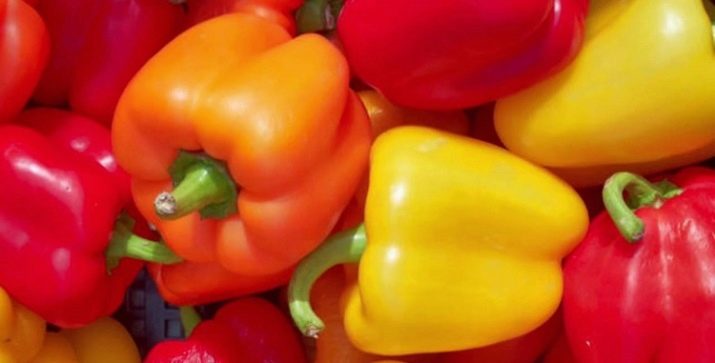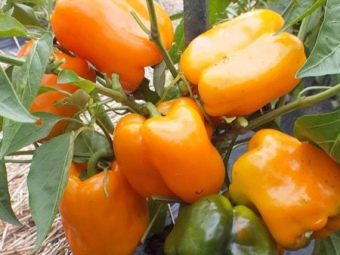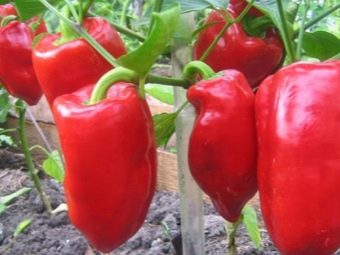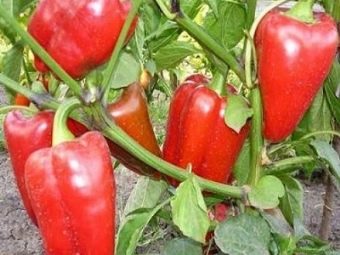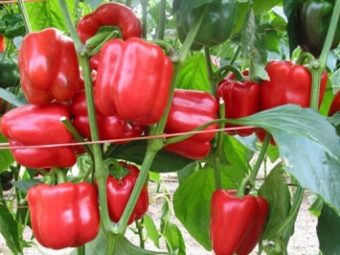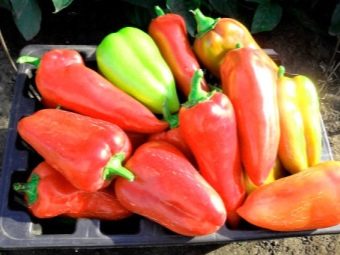Sweet pepper: composition, properties and varieties with a description

Sweet bell pepper has long been a familiar vegetable, which in one form or another is almost always present on our tables. It is cut into salads, added to soups and goulash, and for the winter is prepared preservation. Culture can be found in every garden, only varieties differ.
Characteristic
Bulgarian pepper belongs to the family of nightshade, its fruits are a hollow false berry, in which there is a large number of seeds. The color of the berries varies from light yellow to brown and even purple, but most often there are green and red peppers. Homeland pepper is considered to be Central America - countries such as Mexico and Colombia. By the way, this plant there is a perennial, but in the Russian climate it grows only one season.
After Columbus discovered America, the pepper came to Spain and its friendly Portugal, and from there it quickly spread throughout the Old World, and from there it even got to the Middle East. Today, the culture is grown in almost all countries with tropical and subtropical climates.
Pepper is widely used in cooking. In addition to being eaten fresh, it is also pickled, salted, boiled, stewed, baked and fried. Peppers are cooked on charcoal, grilled, stuffed with other vegetables and minced meat. Peppers are the main ingredient in cooking lecho, it is also included in the composition of ketchup and various sauces.
In Russia, peppers are grown in the Lower Volga region, the Krasnodar Territory and the North Caucasus - in these regions a rather high yield of fruits is gathered in the open air, but in all other areas they require permanent or at least temporary greenhouses and greenhouses.
Chemical composition
Bulgarian pepper is considered to be a real pantry of vitamins, however, by the concentration of vitamin C it can be called the absolute leader. Ascorbic acid is contained in it much more than in black currants and citrus fruits. Pepper contains a high concentration of vitamins P and A. The vegetable contains all the B vitamins: thiamine, choline, riboflavin, pantothenic acid, pyridoxine and folic acid, in addition, it contains quite a lot of tocopherol and phylloquinone.
Mineral content is not far behind the vitamin composition - there are quite a lot of sodium, potassium, magnesium salts, as well as zinc and iron in sweet pepper. Pepper is extremely important for residents of large cities, because its structure is quite large dose of iodine.
In addition, the fruits accumulate capsaicin - it is an alkaloid, which gives the vegetable its original flavor, but most importantly - it makes the vegetable extremely useful for the stomach and intestines of humans.
The composition of sweet pepper can be judged by its color. So, if the product is rich in carotene, the vegetable has pleasant orange or yellow hues, a high concentration of copper gives a red color, and green indicates the prevalence of chlorophyll in the chemical composition.
Benefit and harm
The exceptional composition of sweet pepper causes its usefulness to the human body. Thus, the high content of potassium makes the product indispensable for people suffering from cardiovascular diseases. Due to the large amount of dietary fiber, as well as water, the product becomes useful for the digestive organs. Eating raw vegetables helps regulate intestinal motor function, improve peristalsis, therefore the inclusion of such a product in the diet will allow you to forget about constipation, stomach heaviness and many other unpleasant problems for a long time.
It should be noted that capsaicin contained in the chemical composition has minimal dosages, which makes the product important for all those who suffer from gastritis with reduced secretion. Regular consumption of such a vegetable helps to improve appetite and normalize the processes of assimilation of nutrients in the small intestine.
Increased dose of vitamin C directly affects the immune system, increases the body's protective reserves, is a good prevention of colds and viral diseases. Vitamin C is indispensable for people with thin and brittle blood vessels, and is also useful for improving the condition of bleeding gums.
Vitamins of group B contribute to the normalization of nervous activity, the improvement of psycho-emotional state, the normalization of sleep and the removal of the symptoms of mental overstrain.
Pepper is indicated for diabetes, it is also recommended for inclusion in the diet of pregnant women, and due to its low calorie content, it is prescribed to people suffering from obesity. To combat the extra pounds of sweet pepper is a truly indispensable product. Its pulp contains quite a lot of vegetable protein, which is quickly and fully absorbed by the body and therefore does not create an overload for the digestive tract. It should be noted that in the composition of the product there are no components that can cause harm to a person although sometimes you can find fruit with a rather burning taste. As a rule, this is a consequence of elevated concentrations of capsaicin, because such fruits are better not to give to children, as well as people with pancreatitis, gastritis, ulcers, kidney and liver diseases in the acute stage.
It is very important to buy only such pepper, which was grown in an environmentally friendly way, because on large plantations many pesticides are added to the ground, and the plants themselves are sprayed with chemicals to kill pests. Such substances tend to penetrate into the pulp, which makes the product toxic and dangerous to human health and even human life. Experts say that too early fruits sold in spring and early summer are dangerous in most cases because they are grown for commercial purposes in special greenhouses. Optimal to acquire the fruit from July to September.
Please note that there are no contraindications for the use of Bulgarian pepper by nursing mothers, however, in some cases, the child has an individual intolerance to the product, therefore women should use it when breastfed with caution, gradually increasing the dose.
Calorie and nutritional value
The calorie content of the bell pepper is small - 100 g of the product contains only 29 calories, while the main part of the nutritional value is carbohydrates.
If we talk about BZHU, then the proportion of proteins is about 0.98%, fat - 0.62%, and the amount of carbohydrates - about 5.2-5.5%. In addition, in 100 g of vegetable there is 5 g of fiber, and about 90% is water.
Due to this composition, sweet pepper is considered a truly dietary product that is recommended to be included in the diet of people with a dietary diet.
Sorta
Among the variety of varieties of bell pepper, several are the most popular among Russian gardeners.
- Big Mom - This variety, bred for growing in natural conditions. The bush is semi-sprawling, about 90-100 cm long. The fruits are quite large, each weighs 200 g, and the walls are 12 mm thick. The berries ripen completely 120 days after the first germination of the seedlings, when they reach the technical degree of ripeness, they become saturated orange. Harvest can be used for winter canning and for receiving raw.
- "Bogatyr" - It is a representative of mid-season varieties. Fruits can be harvested 4 months after germination. The bush is rather sprawling, about 60 cm tall, prince-shaped peppers, after aging they acquire a bright scarlet color. The variety is very fruitful - up to 8 kg of peppers are collected from each square meter, while the weight of each fruit varies from 150 to 180 g. Judging by the description, this variety is considered the absolute leader in vitamin C and rutin, and its taste is estimated by experts exceptionally tall.
- Pepper "Swallow" you can collect 115-130 days after sowing, all fruits ripen at one time. Shrubs grow to 70 cm, average spreading. The fruits are quite smooth, their conical shape, the color of ripe berries - light green. Upon reaching full ripeness, the weight of one berry is 70 g, and the wall thickness is 5-7 mm. The variety is characterized by increased resistance to diseases and pests, while the taste of the fruit is saturated, making the culture loved by many local summer residents.
- "Merchant" - This is another variety, which is classified as early maturing, it is optimal for both greenhouses and open ground. Fruits are usually harvested 100-110 days after planting the seeds. Peppers are characterized by a form in the form of a pyramid, the bushes are spreading and rather high - their height is about 1 meter. Mature berries are characterized by red color, the mass of each is about 130 g. The variety “Merchant” is rich in ascorbic acid, the berries are suitable for universal use, and the yield is about 2.5 kg per square meter.
- "Atlant" - the bushes of this pepper are not very long and the spreading is poor, the fruits are surprisingly large, each weighs 170 g, and the wall is 6-7 mm in thickness. At the same time, the berries are tender, crunchy and very juicy. Aging occurs on the 110th day after planting, the mature fruits have a rather saturated lime shade. The fruitfulness is quite good - about 4-5 kilograms per square meter of plantings.
- "Belozerka" - This is one of the most common varieties, which is quite good fruit in the open field. The ripeness reaches 110-115 days, the length of the bush is about 65-75 cm. The berries are cone-shaped, the top is ribbed, represented by various tones - from light brown to red. The weight of one berry is approximately equal to 130 g, and the wall thickness is about 7.5 mm. The fruits are quite tasty, and at the same time the fruit is extremely abundant - up to 8 kg / m2 The berries have good keeping quality and resistance to transportation, and the plants themselves are quite resistant to rot and many other fungal infections.
- Big Dad Variety attributed to the early ripening, it begins to bear fruit on day 90, while the berries grow large and thick-walled: the weight of each is 150 g, and the thickness of the pulp is 6-8 mm. The final ripeness of the fruit is usually reached at the moment when painted in dark purple color. This variety gives a good harvest - 7-9 kg of berries are harvested from each square meter, while they tolerate storage and transportation quite well and are characterized by a tart pleasant taste.
- "California miracle" - This is a species that is classified as mid-season. Aging is achieved on a 125-135 day after seeding. The fruits have a cuboid shape, the berries are very juicy and rather sweet. The weight of each pepper is about 150 g, and the walls are 8–9 mm thick. Ripe berries become red. Fruity is about 3 kg / m2, while the product parameters are extremely high.
- Orange Miracle - this grade is planted both in an open ground on the street, and in greenhouses and hotbeds. Most often it is cultivated in the south of Russia. The bush is quite long - the height of the stem exceeds 1 m, while the plant is resistant to tobacco mosaic. The shape of the fruit is cuboid, the color is brown-orange. The mass of each berry reaches 250 g, and the wall thickness is approximately 10 mm. The yield is extremely high - up to 14 kg / m2.
- "Gift of Moldova" - this variety is bred for cultivation in greenhouses, however, and in natural conditions at favorable temperatures it can give a good harvest. The plant is low, not more than 50 cm in height, half-talon. The peppers are cone-shaped, the length of the berries is 10 cm, and the thickness of the pulp is 7 mm.
The varieties “Hercules”, “Victoria”, “Gnome” and “Kubyshka” are very popular with domestic summer residents.
Growing up
In southern Russia, the plant is grown in open ground, but in more northern regions it can only be cultivated in greenhouses. In the central part of the country, cultivation is carried out in a seedling way - a young, fragile plant is kept in indoor conditions, and when the threat of returning spring frosts is completely bypassed, it is transferred to the main place on the street. The seeds of the plant are planted in a seedling box filled with a soil substrate at the very beginning of the third winter month.
Peppers belong to rather thermophilic cultures, therefore for germination it is desirable to provide temperature at the level of 25-27 degrees, and after sprouting, it can be reduced to 21-24 degrees. Keep in mind, if the temperature background drops to 14 degrees, the peppers will stall in growth. As soon as the very first permanent leaflets appear, the plants dive according to the 7x7 or 6x6 cm scheme. The plants are placed on a warm and sunny window so as to provide them with a long light day. Watering is carried out regularly, but not plentiful, otherwise the probability of rotting of the roots is high.
Seedlings are planted after the threat of recurrent frosts is completely passed. As a rule, this is the last decade of May (in central Russia). If you plant the peppers earlier, they may die. Optimally, the plant would have 7-9 leaves each, and shortly before moving to open ground it should be hardened - to do this, the plant is carried out outside for a week, gradually increasing the residence time so that just before transplanting the seedlings spend the whole day outside the house .
Land under the peppers should be prepared in the fall. For this, humus is introduced into the ground at the rate of 4.5 kg / sq. In case of its absence, the rotted compost will completely fit. In early spring, the earth is enriched with complex fertilizers, and the treatment is repeated 5-7 days before planting.
The plant needs constant care: it is necessary to tear out weeds in a timely manner, water and apply additional fertilizing to the soil. It is very important to provide him with normal lighting, because if the peppers are planted on shaded beds, they go to growth - they stretch out and completely drop all the ovaries. The ground under the plant must be necessarily wet. Without constant irrigation, plants simply become dwarfed, and their fruits are quite small and often irregular in shape.
Peppers are very sensitive to an excess of nitrogen, while the green mass of the plant increases dramatically, but the number of flowers remains minimal.
In the first decade of August, it is necessary to pinch the tops of the stalks and remove all the buds and flowers, since the fruits on them will not have time to reach maturity before the onset of cold weather. If you are planting tall varieties, you need to tie them to a support, otherwise the stem will break off under its own weight. The plant responds well to top dressing. Particularly effective is chicken manure or mullein mixed with superphosphate.
Storage
Fresh bell peppers are quite perishable products. They are stored fresh for no more than a week in a cool place, and to preserve the taste they resort to freezing, preservation and pickling.
Many housewives prefer to dry the pepper. In this form, it has a pronounced flavor that allows you to add it to soups and main dishes in meat broth. And, of course, to keep the product as long as possible, you should choose the right vegetables.
When buying, pay attention to the appearance of pepper. Give preference to smooth berries without dents, rot, cracks and other visible defects.
Use
Bulgarian peppers can be eaten raw, it is very tasty both in the form of a separate dish, and together with other vegetables. It is especially well combined with tomatoes, cucumbers and leaf lettuce. The product is quite often used for making summer snacks, while it is filled with oil and lemon juice.
Pepper is extremely tasty in baked form.It is cooked on charcoal or in a grill pan, while quite often the berry is filled with other vegetables or meat with rice.
As for winter preservation, then any hostess is in the first place lecho with tomatoes and peppers. This product is served with potatoes, meat and cereals.
Keep in mind that When cooking, do not combine raw and boiled peppers - such a combination is quite hard for the stomach and can cause digestive problems.
Sweet peppers are often added to homemade ketchups, as well as vegetable juices, which include pomace of tomatoes, carrots, beets, garlic and cabbage.
For information on how to cook delicious roasted peppers with garlic, see the next video.









